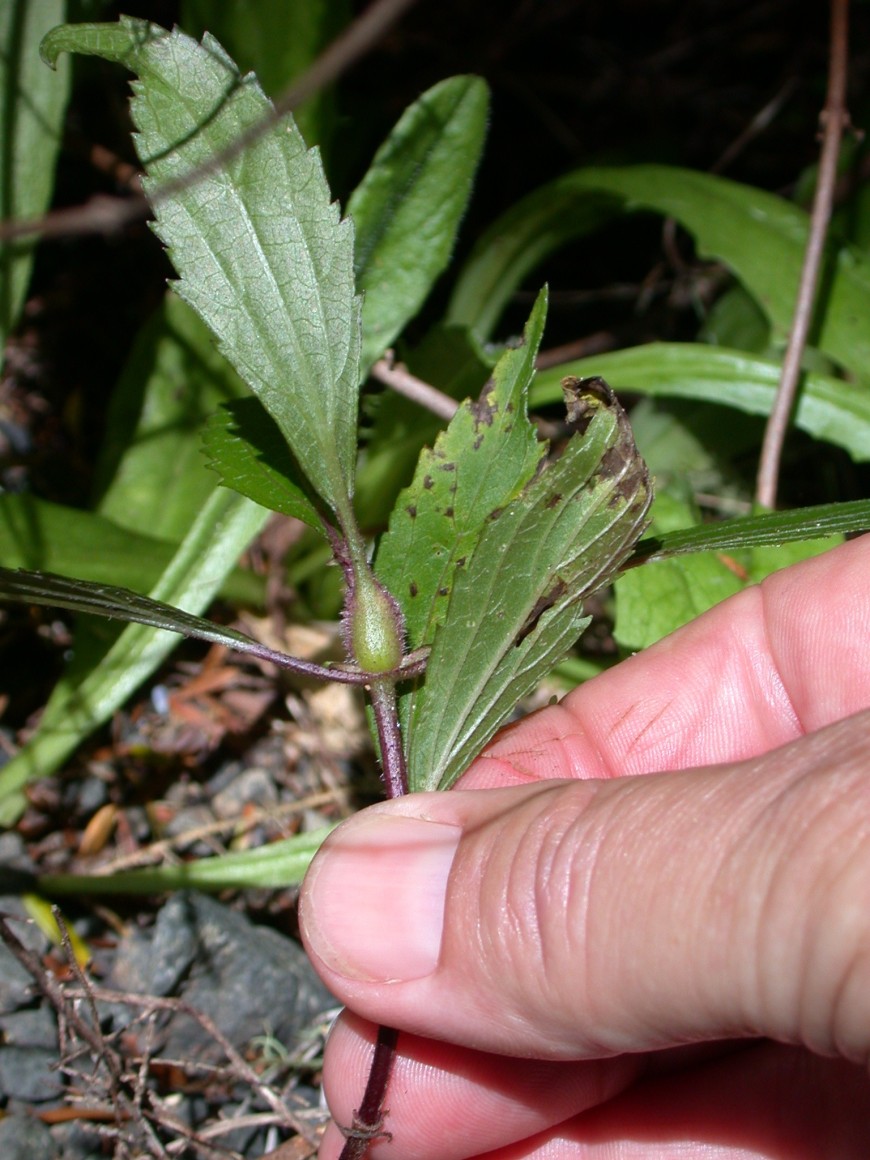Mist flower gall fly
History in New Zealand
The mist flower gall fly (Procecidochares alani) is native to Mexico and was first imported from Hawai'i by Manaaki Whenua - Landcare Research in 2000. This agent helped to successfully control mist flower in Hawai'i in the 1980s, and was also released in Australia and South Africa. In 2001 the mist flower gall fly was released widely throughout the regions of New Zealand worst affected by mist flower (Northland and Auckland) and established readily. The mist flower gall fly appears to complement the most effective agent, the mist flower fungus (Entyloma ageratinae).
How would I find/recognise it and what is its lifecycle?
The adult fly is rarely seen in the field, but the galls (swellings) on mist flower stem nodes that contain internally feeding fly larva are easy to recognise. Galls start small but can reach over 2 cm in diameter, particularly when they contain several larvae.
Image: mist flower gall fly gall exit holes.
Occasionally, you may see adult flies resting on mist flower plants. They have boldly patterned wings and are similar in size (8 mm wingspan) and appearance to several other introduced biological control agents such as the closely related Mexican devil gall fly (Procecidochares utilis) and the thistle gall flies (Urophora spp.).
Image: mist flower gall fly on mist flower.
The females insert eggs into the apical or lateral growing points of mist flower stems. The eggs hatch after about 3–5 days and the larvae burrow into the tender buds. As the larvae feed and grow, the plant forms gall tissue around them.
Larvae complete development in about 3 weeks. The larvae pupate in the gall, having first gnawed a thin 'window' through which the adult fly emerges 2–3 weeks later. Adults mate and lay eggs immediately and live for about a fortnight.
Image: mist flower gall fly pupa inside a gall.
Image: mist flower gall fly pupa.
Under warm conditions the gall fly can breed continuously. The gall fly will remain mostly dormant in the larval or pupal stage through winter.
How does it damage mist flower?
Mist flower gall flies trick the plant into diverting valuable nutrients, which would normally be used for plant growth, into the galls to feed the developing fly larvae. This retards stem elongation, resulting in shorter, less vigorous mist flower plants that can be more easily out-competed by desirable vegetation.

Image: gall on mist flower.
Will it attack other plants?
Mist flower gall flies are extremely unlikely to attack anything except mist flower (Ageratina riparia). Even the closely related Mexican devil weed (A. adenophora) is unlikely to be attacked. In confined laboratory tests mist flower gall flies very occasionally laid eggs on Mexican devil weed, but the larvae never survived, and galls were never formed.
Conversely, the Mexican devil weed gall fly does not attack mist flower. Galls of both these fly species do look very similar, so you can only identify the species of fly if you allow adults to emerge.
How effective is it?
The mist flower gall fly established within 1-3 years at 87% of 30 monitored release sites across Northland and Auckland. It dispersed at least 5 km occurred in one year, and is now well spread across the northern parts of the North Island of New Zealand.
The average levels of galling in New Zealand are higher than the average of 0.46 galls/stem reported for Hawai’i.
The mist flower gall fly and fungus can complement one another and attack a mist flower plant simultaneously because the fungus generally doesn’t damage the very young leaves and growing points that the gall fly needs for oviposition and gall initiation. Both agents now coexist at sites across northern New Zealand.
The mist flower gall fly is attacked by the parasitoid (Megastigmus sp.). Parasitism, together with some predation of galls by birds or rodents, is likely to be suppressing mist flower gall fly populations to some extent. Observations suggest the gall fly is very good at locating small, isolated mist flower plants (where the gall fly probably benefits from temporary escape from parasitism), so the mist flower gall fly may help to suppress new invasions of mist flower and reduce the weeds’ ability to spread.
How can I get the most out of it?
It is not necessary to spread the mist flower gall fly across the northern parts of North Island. However, if you do come across any infestations of mist flower that are uninfected (e.g. on outlying islands, or in the South Island), then it may be worth acting to establish a population.
How do I select a release site?
The mist flower gall fly does better in sunnier and drier sites.
Read the Guidelines for selecting release sites for biocontrol agents.
How do I collect it for release at other sites?
Collect large mature galls, without emergence holes, during summer and autumn. Aim to shift at least 100 galls. Leave galls on the ground at the new site.
You can also collect galls and keep in a mesh cage, then release adult flies at other sites. This is more labour-intensive than transferring galls, but will avoid accidentally releasing the parasitic Megastigmus wasp at new sites.
How do I manage the release sites?
Avoid activities that will interfere with the mist flower gall fly's life cycle, such as herbicide, mowing or grazing of mist flower.


